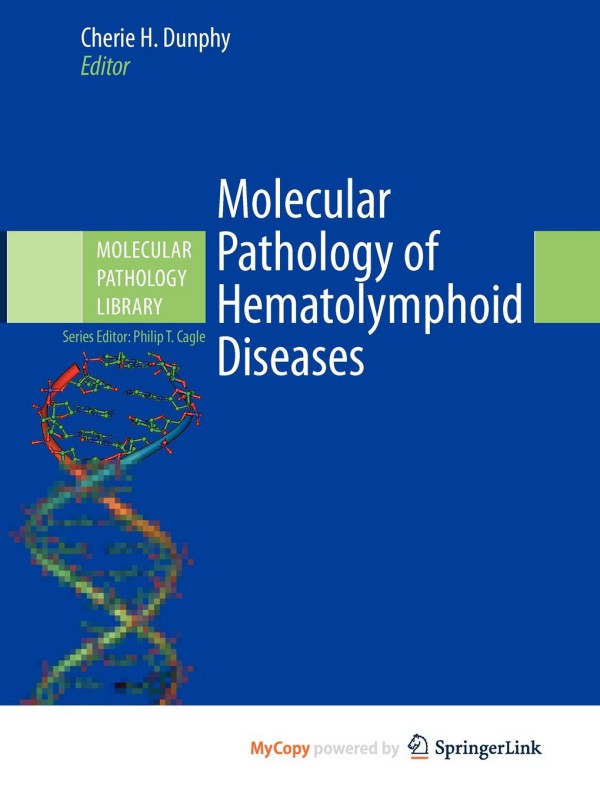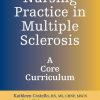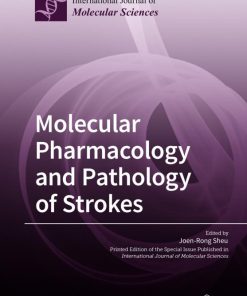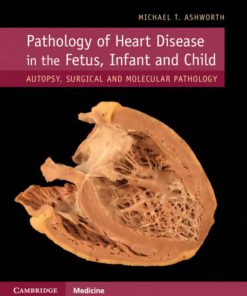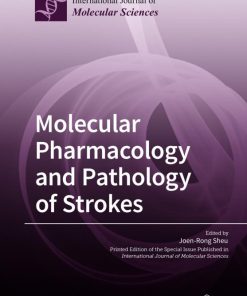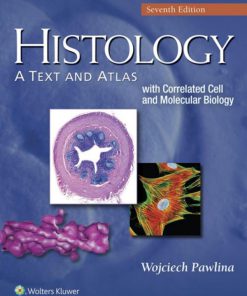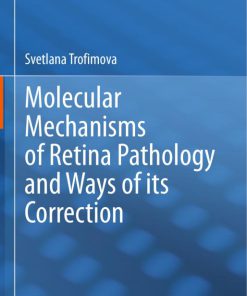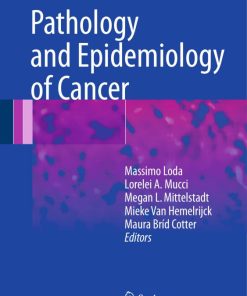Molecular Pathology of Hematolymphoid Diseases 1st Edition by Cherie H Dunphy ISBN 1441956980 9781441956989
$50.00 Original price was: $50.00.$25.00Current price is: $25.00.
Authors:Cherie H. Dunphy , Series:Pathology [37] , Tags:Medical / Clinical Medicine Medical / Pathology , Author sort:Dunphy, Cherie H. , Languages:Languages:eng , Published:Published:Apr 2010 , Publisher:Springer , Comments:Comments:The past two decades have seen an ever-accelerating growth in knowledge about molecular pathology of human diseases which received a large boost with the sequencing of the human genome in 2003. Molecular diagnostics, molecular targeted therapy and genetic therapy are now routine in many medical centers. The molecular field now impacts every field in medicine, whether clinical research or routine patient care. There is a great need for basic researchers to understand the potential clinical implications of their research whereas private practice clinicians of all types (general internal medicine and internal medicine specialists, medical oncologists, radiation oncologists, surgeons, pediatricians, family practitioners), clinical investigators, pathologists and medical laboratory directors and radiologists require a basic understanding of the fundamentals of molecular pathogenesis, diagnosis and treatment for their patients.Traditional textbooks in molecular biology deal with basic science and are not readily applicable to the medical setting. Most medical textbooks that include a mention of molecular pathology in the clinical setting are limited in scope and assume that the reader already has a working knowledge of the basic science of molecular biology. Other texts emphasize technology and testing procedures without integrating the clinical perspective. There is an urgent need for a text that fills the gap between basic science books and clinical practice.In the Molecular Pathology Library series the basic science and the technology is integrated with the medical perspective and clinical application. Each book in the series is divided according to neoplastic and non-neoplastic diseases for each of the organ systems traditionally associated with medical subspecialties.Each book in the series is organized to provide specific application of molecular pathology to the pathogenesis, diagnosis and treatment of neoplastic and non-neoplastic diseases specific to each organ system. These broad section topics are broken down into succinct chaptersto cover a very specific disease entity. The chapters are written by established authorities on the specific topic from academic centers around the world. In one book, diverse subjects are included that the reader would have to pursue from multiple sources in order to have a clear understanding of the molecular pathogenesis, diagnosis and treatment of specific diseases. Attempting to hunt for the full information from basic concept to specific applications for a disease from varied sources is time-consuming and frustrating. By providing this quick and user-friendly reference, understanding and application of this rapidly growing field is made more accessible to both expert and generalist alike.As books that bridge the gap between basic science and clinical understanding and practice, the Molecular Pathology Series serves the basic scientist, the clinical researcher and the practicing physician or other health care provider who require more understanding of the application of basic research to patient care, from “bench to bedside.” This series is unique and an invaluable resource to those who need to know about molecular pathology from a clinical, disease-oriented perspective. These books will be indispensable to physicians and health care providers in multiple disciplines as noted above, to residents and fellows in these multiple disciplines as well as their teaching institutions and to researchers who increasingly must justify the clinical implications of their research.
Molecular Pathology of Hematolymphoid Diseases 1st Edition by Cherie H Dunphy – Ebook PDF Instant Download/Delivery. 1441956980, 9781441956989
Full download Molecular Pathology of Hematolymphoid Diseases 1st Edition after payment
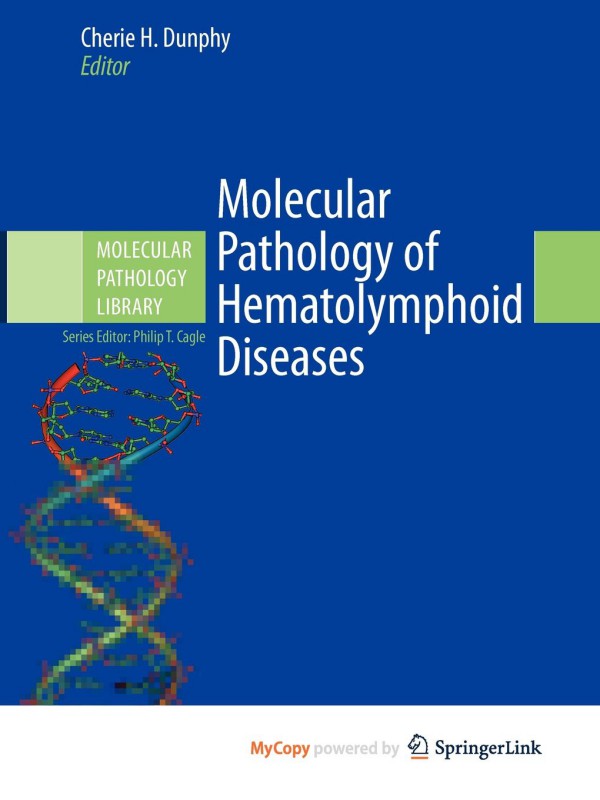
Product details:
ISBN 10: 1441956980
ISBN 13: 9781441956989
Author: Cherie H Dunphy
The past two decades have seen an ever-accelerating growth in knowledge about molecular pathology of human diseases, which received a large boost with the sequencing of the human genome in 2003. Molecular diagnostics, molecular targeted therapy and genetic therapy, are now routine in many medical centers. The molecular field now impacts every field in medicine, whether clinical research or routine patient care. There is a great need for basic researchers to understand the potential clinical implications of their research whereas private practice clinicians of all types (general internal medicine and internal medicine specialists, me- cal oncologists, radiation oncologists, surgeons, pediatricians, family practitioners), clinical investigators, pathologists and medical laboratory directors and radiologists require a basic understanding of the fundam- tals of molecular pathogenesis, diagnosis, and treatment for their patients. Traditional textbooks in molecular biology deal with basic science and are not readily applicable to the medical setting. Most medical textbooks that include a mention of molecular pathology in the clinical s- ting are limited in scope and assume that the reader already has a working knowledge of the basic science of molecular biology. Other texts emphasize technology and testing procedures without integrating the clinical perspective. There is an urgent need for a text that fills the gap between basic science books and clinical practice. In the Molecular Pathology Library series, the basic science.
Molecular Pathology of Hematolymphoid Diseases 1st Table of contents:
1
Molecular Oncogenesis
Introduction
The Initiation and Maintenance of Oncogenic Programs: Genetic and Epigenetic Changes
Types of Genetic Changes in Hematolymphoid Neoplasms
Genetic Changes in Leukemia and Myeloid Disorders
Multistep Pathogenesis and the Cooperativity of Genetic Alterations
Proliferation and/or Survival Signals
Block of Differentiation
Epigenetic Changes and Their Impact on Leukemogenesis
The Involvement of Stem Cells and Stem Cell Characteristics in Leukemia
Therapies Targeting Leukemia-Specific Molecular Alterations
Oncogenesis of Malignant Lymphoma
Programmed Genetic Changes of Antigen Receptor Genes during Normal Lymphocyte Development
Generation of Antibody Diversity and B-Cell Lymphoma Development
Primary Immunoglobulin Gene Rearrangement
Oncogene Activation Caused by Illegitimate Recombination during Immunoglobulin Gene Rearrangement
IGH Translocations may Often be Detected in the Absence of Clinical Disease
The Germinal Center Reaction and Lymphomagenesis
Mutational Analysis of IGH Genes Captures the History of Malignant B-Cell Clones
Genetic Alterations in Peripheral T-Cell Lymphoma
Oncogenes and Oncogenic Pathways in Malignant Lymphoma
The Properties of the Activated Oncogene Determine the Biologic and Clinical Behavior of Lymphomas
BCL-2
CCND1 (Cyclin D1)
C-MYC
BCL-6
Deregulation of the NF-kB Pathway
Tumor Suppressor Genes in Lymphoma
Inhibition of Death Receptor Signaling
MicroRNA Deregulation
Infectious Agents Contributing to Lymphomagenesis
Conclusion
References
2
Genetic Predispositions for Hematologic and Lymphoid Disorders
Introduction
Neurofibromatosis
Molecular Pathogenesis of NF1
Hematolymphoid Disorders Associated with NF1
Tests for NF1
Noonan Syndrome
Molecular Pathogenesis of NS
Hematolymphoid Disorders Associated with NS
Tests for NS
Fanconi Anemia
Molecular Pathogenesis of FA
Hematologic Disorders Associated with FA
Pathogenesis of Neoplasms Associated with FA
Tests for FA
Bloom’s Syndrome
Molecular Pathogenesis of BS
Hematolymphoid Disorders Associated with BS
Tests for BS
Nijmegen Breakage Syndrome
Molecular Pathogenesis of NBS
Hematolymphoid Disorders Associated with NBS
Tests for NBS
Ataxia-Telangiectasia
Molecular Pathogenesis of AT
Hematolymphoid Disorders Associated with AT
Tests for AT
Dyskeratosis Congenita
Molecular Pathogenesis of DC
Hematolymphoid Disorders Associated with DC
Tests for DC
Shwachman–Diamond Syndrome
Molecular Pathogenesis of SDS
Hematopoietic Disorders Associated with SDS
Tests for SDS
Diamond–Blackfan Anemia
Molecular Pathogenesis of DBA
Hematopoietic Disorders Associated with DBA
Tests for DBA
Primary Immune Deficiency Disorders
X-Linked Lymphoproliferative Disorder (Also See Chap. 38)
Molecular Pathogenesis of XLP
Testing for XLP
Hyper-IgM Syndromes (Also See Chap. 38)
Pathogenesis of HIGM
Hematolymphoid Disorders Associated with HIGM
Tests for HIGM
Hyper-IgE Syndromes
Pathogenesis of HIES
Hematolymphoid Disorders Associated with HIES
Common Variable Immune Deficiency (Also See Chap. 38)
Molecular Pathogenesis of CVID
Hematolymphoid Disorders Associated with CVID
Tests for CVID
Wiskott–Aldrich Syndrome (Also See Chap. 39)
Hematolymphoid Disorders Associated with WAS
Tests for WAS
Autoimmune Lymphoproliferative Syndrome (Also See Chap. 38)
Molecular Pathogenesis of ALPS
Hematolymphoid Disorders Associated with ALPS
Tests for ALPS
Congenital Neutropenia Syndromes
Molecular Pathogenesis of Congenital Neutropenia Syndromes
Hematologic Neoplasias Associated with Congenital Neutropenia Syndromes
Tests for Congenital Neutropenia Syndromes
Summary
References
3
Prognostic Markers
Introduction
Chronic Lymphocytic Leukemia (Also See Chap. 16)
Immunoglobulin Variable Gene Mutation Analysis
Genomics
Multiple Myeloma (Also See Chap. 19)
Acute Myeloid Leukemia (Also See Chaps. 34 and 35)
FMS-Related Tyrosine Kinase 3 (Also See Chap. 35)
Nucleophosmin (Also See Chap. 35)
Non-Hodgkin Lymphoma
Diffuse Large B-Cell Lymphoma (Also See Chap. 22)
Marginal Zone Lymphoma (Also See Chap. 17)
References
4
Cancer Stem Cells: Potential Targets for Molecular Medicine
Introduction
The Cancer Stem Cell Hypothesis
Cancer Stem Cells, Defined
Historical Perspective
The Biology of Cancer Stem Cells
Cancer Stem Cell Identification
Functional Identification
In Vivo CSC Isolation Methods
In Vitro CSC Assays
Molecular Methods
Phenotypic Identification
Cell Surface Markers
In Vivo Monitoring of CSC
Molecular Pathogenesis of Cancer Stem Cells
Pathogenesis of CSC in Blast Crisis of CML (Also See Chap. 30)
Molecular Changes Contributing to CSC Propagation in Blast Crisis of CML
Clinical Implications of Cancer Stem Cells
CSC in Cancer Diagnosis, Prognosis, and Monitoring
Cellular and Molecular Assays
Cellular and Molecular Imaging
CSC-Directed Cancer Treatment
References
5
Gene Therapy for Leukemia and Lymphoma
Introduction
Viral Vectors Used for Gene Therapy
Gene Targeting to Destroy Tumor Cells Directly
Tumor Suppressor Gene Therapy
Suicide Gene Therapy
RNA Interference
Gene Transfer to Enhance Immune Responses to Tumor Cells
Gene Transfer of Immunostimulating Cytokines
Gene Transfer of Costimulating Molecules
Modification of T-Cell Function by Gene Transfer
Chimeric T-Cell Receptors
Gene Transfer of TCR for Retargeting
Gene Transfer of Protective Genes
Conclusion and Future Directions
References
6
Chemical and Environmental Agents (Including Chemotherapeutic Agents and Immunosuppression)
Introduction
Ionizing Radiation
Childhood Studies
Background Radiation (Natural and Man-Made)
Parental Occupational Exposures
Parental Diagnostic Exposures
Childhood Diagnostic Exposures
Adult Studies (Table 6.1)
Background Radiation (Natural and Man-Made)
Occupational Exposures
Diagnostic/Treatment Exposures
Electromagnetic Fields
Childhood Studies
Direct Childhood Exposures
Parental Occupational Exposures
Adult Studies (Table 6.2)
Residential Exposures
Occupational Exposures
Chemical Exposures
Childhood Studies
Pesticides and Fungicides
Solvents, Benzene and Other Hydrocarbons
Adult Studies (Table 6.3)
Pesticides and Fungicides
Solvents, Benzene and Other Hydrocarbons
Smoking
Childhood Studies
Parental Smoking
Adult Studies (Table 6.4)
Alcohol
Childhood Studies
Parental Alcohol Consumption
Adult Studies (Table 6.5)
Diet, Vitamin, and Folate Supplementation
Childhood Studies
Adult Studies (Table 6.6)
Drinking Water
Child Studies
Adult Studies
Immunosuppression and Viruses
Viruses (Also See Chap. 7)
Child Studies
Adult Studies (Table 6.7)
Transplantation
Arthritis
Chemotherapeutic Agents
Discussion
References
7
Viral Oncogenesis
Introduction
Do In Vitro Models Reflect In Vivo Effects?
Epstein–Barr Virus
Histochemical Assays for EBV
Human Herpes Virus 8/Kaposi’s Sarcoma-Associated Herpes Virus
Human T-Lymphotropic Virus
Hepatitis C Virus
Simian Vacuolating Virus 40
Measles Paramyxovirus
Conclusion
References
8
Techniques to Determine Clonality in Hematolymphoid Malignancies
Introduction
Cancer as Clonal Process
X Inactivation
Lymphomas
Lymphoid Development
B Cell Clonality
Light Chain Restriction
Molecular Methods for Determining B Cell Clonality
T Cell Clonality
T Cell Receptor Restriction
Molecular Methods for Determining T Cell Clonality
Natural Killer Cell Clonality
Other Clonal Markers in Lymphoid Malignancies
Translocations Resulting in Overexpression of Growth Regulatory Genes
Translocations Resulting in Production of a Novel Growth-Stimulating Protein
Clonal Viral Integration
Myeloid Stem Cell Neoplasms
Clonal Recurrent Chromosomal Translocations
Gene Mutations in Leukemia (Also see Chap. 35 on Acute Myeloid Leukemias with Normal Cytogenetics)
JAK2 Mutation in Myeloproliferative Neoplasms (Also see Chap. 31 on Non-CML Myeloproliferative Neopl
Array-Based Techniques that may Determine Clonality
Summary
References
9
Techniques to Detect Defining Chromosomal Translocations/Abnormalities
Introduction
Conventional (Routine) Cytogenetics
Fluorescence In-Situ Hybridization (FISH)
Cytogenetic Abnormalities in Hematolymphoid Malignancies
Acute Myeloid Leukemias (AML)
World Health Organization (WHO): AML with Recurrent Cytogenetic Translocations t(8;21)
FISH for t(8;21)
t(15;17)(q22;q21)
FISH for t(15;17)
inv(16)(p13q22)/del(16)(q22)/t(16;16)(p13;q22)
FISH for Chromosome 16 Rearrangements
11q23 Rearrangements
FISH for 11q23 (MLL)
Abnormalities Seen in AML with Multi-Lineage Dysplasia
Secondary or Therapy-Related AML
Chronic Myeloid Leukemia (CML): t(9;22)(q34;q11.2)
Myelodysplastic Syndromes (MDS)
5q− Syndrome
Monosomy 7/7q—
Other Abnormalities in MDS
Acute Lymphoblastic Leukemia (ALL)
Cytogenetic Abnormalities Seen in T-ALL
Cytogenetic Abnormalities Seen in Pre B-ALL
Numerical Abnormalities in Pre-B-ALL
Structural Rearrangements
Translocations Associated with Pre B ALL
t(12;21)(p13;q22)
Myeloid Lymphoid Leukemia (MLL) Rearrangements
t(4;11)(q21;q23)
t(1;19)(q23;p13.3)
t(9;22)(q34;q11.2)
Pediatric ALL
Adult ALL
Non-Hodgkin Lymphomas (NHL)
Follicular Lymphoma and Diffuse Large B-Cell Lymphomas with t(14;18)
t(14,18)(q32:q21) Follicular and Diffuse Large B-Cell Lymphomas
Mantle Cell Lymphoma with t(11;14)
FISH for t(11;14)(q13;q32) Mantle Cell Lymphoma
Burkitt Lymphoma with t(8;14) and Other Burkitt Translocations
FISH for t(8;14) and Other Burkitt Translocations
Anaplastic Large Cell Lymphoma
FISH for ALK Rearrangements
Splenic Marginal Zone Lymphoma
Mucosa-Associated Lymphoid Tissue Lymphoma (MALT)
Multiple Myeloma (Plasma cell myeloma)
FISH Studies for Multiple Myeloma
Spectral Karyotyping
DNA Microarray
Polymerase Chain Reaction
Reverse Transcriptase PCR (RT-PCR)
Real-Time Quantitative PCR
BCR-ABL1 [t(9;22)]PML-RARA [t(15;17)]BCL2-IGH [t(14;18)]MLL (11q23)
Other Translocations
Immunohistochemistry
Acute Myeloid Leukemias
PAX 5 [t(8;21)]CBFb(beta)-SMMHC Protein [inv(16)(p13q22)]Non-Hodgkin Lymphomas
BCL-2 [t(14;18)]Cyclin D1 [t(11;14)]C-myc (Burkitt translocations)
ALK-1 [t(2;5)]Multiple Myeloma
Cyclin D1
References
10
Molecular Techniques to Detect Disease and Response to Therapy: Minimal Residual Disease
Overview
Molecular Approaches to MRD Monitoring
Patient Samples
Targets
Antigen Receptor Rearrangements in the Immunoglobulin Super Family
Chromosomal Translocations Resulting in Fusion-Gene Transcripts Followed by RNA Analysis
Chromosomal Aberrations Resulting in a Fusion Gene Followed with DNA
Additional Considerations in the Use of RNA or DNA
“Point” Mutations
Aberrant Gene Expression
Other Techniques to Monitor MRD
Karyotype and FISH
Flow Cytometry
Microarrays
Transcription-Mediated Amplification (TMA)-Hybridization Protection Assay (HPA)
Quantitative PCR and RT-PCR
Quantitative PCR Techniques (Nested, Competitive, Real-Time)
RQ-PCR Assay Design
Samples
RNA Extraction
Reverse Transcription (RT)
RQ-PCR Amplification
Quantitation, Standard Curve Method
Quantitation, DDCT Method
Data Analysis and Reporting of Results
Units of Measurement and Assay Standardization
Sensitivity, Specificity, and Precision
Controls/Normalizing Genes
Assay Validation
Working with Clinicians
Ensuring Quality
Future Directions
References
11
Detection of Resistance to Therapy in Hematolymphoid Neoplasms
Introduction
Resistance to Targeted Tyrosine Kinase Inhibitors
Resistance to Inhibitors of BCR-ABL
Mutations in the ABL Tyrosine Kinase Domain
Amplification of the BCR-ABL Fusion Gene
BCR-ABL Independent Resistance: Downstream Targets
KIT Mutation and Imatinib Response
FLT3 IN AML
Multidrug Resistance
P-glycoprotein (MDR-1)
Detection of MDR in Hematologic Malignancies
Other Multidrug Resistance Proteins
Other Molecular Mechanisms of Resistance
Microarray Analysis
References
12
Monitoring Engraftment of Bone Marrow Transplant by DNA Fingerprinting
Introduction
A Brief History of DNA Fingerprinting Methods
Past
Present
Future
Monitoring Engraftment of Bone Marrow Transplant
Microsatellite Markers
Technical Considerations
Identification of Informative Markers
Quantitative Calculations
Sensitivity
Clinical Considerations
Enriched Populations
Chromosomal Abnormalities
Impact on Future Genetic Testing
References
13
Gene Expression Profiling
Introduction
Techniques of Gene Expression Profiling
Supervised Gene Expression Profiling
Unsupervised Gene Expression Profiling
Usefulness of Ready-Made Macroarrays
Practical Applications in Diagnostic Hematopathology
Prognostic Factors in Chronic Lymphocytic Leukemia and Correlation with Practical Clinical Applicabi
IgVH Mutational Status
ZAP70
Methods of Detection of ZAP70 Expression
Discordance Between IgVH Mutational Status and ZAP70 Expression
Diagnosis of Mantle Cell Lymphoma
Diagnosis of Hairy Cell Leukemia
Grade and Disease Aggressiveness in Follicular Lymphoma
Subgrouping Diffuse Large B-Cell Lymphoma and Correlation with Immunohistochemical Markers
Differentiation of Classical Hodgkin Lymphoma from Lymphocyte-Predominant Hodgkin Lymphoma and From
Class Assignment of Pediatric Precursor B Lymphoblastic Leukemia
Distinctive Gene Expression Signatures of Precursor T-Cell Lymphoblastic Leukemia and Correlation wi
Association of Distinct Gene Expression Profiles with Acute Myeloid Leukemias with Recurring and Com
AMLS with FLT3 Length Mutation
Summary
References
14
Proteomics of Human Malignant Lymphoma
Introduction
Biological Samples for Proteomics
General Strategy for Proteomics
Protein Microarrays
Mass Spectrometry-Based Proteomics
Peptide Sequencing by MS/MS
Quantitative Proteomics
Proteomic Studies of Human Malignant Lymphoma
Proteomic Studies of B-Cell Lymphomas
Analysis of Interacting Partners of B-Cell Lymphoma Oncogenes
Proteomic Analysis of Follicular Lymphoma Transformation
Proteomic Consequences of Signaling Pathway Inhibition
Global Protein Profiling Studies
Burkitt Lymphoma
Hodgkin Lymphoma
Proteomic Studies for Identification of Potential Lymphoma Biomarkers
Protein Identification From FFPE Cells
Proteomic Studies of Anaplastic Large Cell Lymphoma
Global Profiling of ALCL Proteome
Identification of ALK Interactome
Proteomic Changes Induced by HSP90
Conclusions and Future Directions
References
15
Mouse Models of Hematolymphoid Malignancies
Introduction
Hematopoiesis
Characterization of Mouse Models
Clinical Pathology
Complete Blood Count
Biochemical Parameters
Anatomic Pathology
Macroscopic Evaluation
Microscopic Evaluation
Ancillary Testing
Lymphoid Neoplasms
Nonlymphoid Neoplasms
Myeloid Leukemia
Erythroid Leukemia
Conclusion
References
16
Chronic Lymphocytic Leukemia/Small Lymphocytic Lymphoma
Introduction
Familial Predisposition
Cytogenetic Features
Immunoglobulin Genes
Epigenetic Factors
Clinical Implications
References
17
Marginal Zone B-Cell Lymphoma
Introduction
Extranodal Marginal Zone Lymphoma of Mucosa-Associated Lymphoid Tissue (MALT Lymphoma)
Definition
Clinical Features
Morphology and Immunophenotype
Prognosis and Predictive Factors
Cytogenetic and Molecular Genetic Features
t(11;18)(q21;q21)/API2-MALT1
t(14;18)(q32;q21)/IGH-MALT1
t(1;14)(p22;q32)/BCL10-IgH
The t(11;18), t(14;18), and t(1;14) Activate the NF-kB Pathway
t(3;14)(p14;q32)/Forkhead Box P1-IGH
Translocation-Negative Cases
Differential Diagnosis
Immunoproliferative Small Intestinal Disease
Definition
Clinical Features
Morphology and Immunophenotype
Cytogenetic and Molecular Genetic Features
Nodal Marginal Zone Lymphoma
Definition
Clinical Features
Morphology and Immunophenotype
Differential Diagnosis
Cytogenetic and Molecular Genetic Features
Pediatric Nodal Marginal Zone Lymphoma
Splenic B-Cell Marginal Zone Lymphoma
Definition
Clinical Features
Prognosis and Predictive Factors
Morphology and Immunophenotype
Differential Diagnosis
Cytogenetic and Molecular Genetic Features
References
18
Lymphoplasmacytic Lymphoma
Introduction
Epidemiology
Cell of Origin
Cytogenetics
Molecular Genetics
Proteinomics
Activated Signaling Pathways
Differential Diagnosis
Conclusions
References
19
Molecular Pathology of Plasma Cell Neoplasms
Introduction
Techniques for the Assessment of Molecular Abnormalities in Plasma Cell Neoplasms
Metaphase Cytogenetic Studies
Fluorescence In Situ Hybridization Analysis
Immunohistochemistry
Array-Based Genotyping
Clinically Significant Molecular Abnormalities in Plasma Cell Myeloma
Chromosome 13 Abnormalities
Del(17p) and p53 Abnormalities
Immunoglobulin Heavy Chain (14q32) Translocations
t(11;14)(q13;q32) IGH/CCND1
t(4;14)(p16;q32) MMSET/IGH
t(14;16)(q32;q23) IGH/CMAF
Other IGH Translocations
Other Chromosomal Abnormalities
A Practical Approach to Molecular Evaluation of Plasma Cell Myeloma
References
20
The Roles of Molecular Techniques in the Diagnosis and Management of Follicular Lymphoma
Introduction
Practical Aspects of Molecular Genetic Testing in the Diagnosis and Management of Follicular Lymphom
Molecular Genetic Tests Available for FL
The Molecular Pathogenesis of FL and Its Impact on Molecular Diagnostics
What Goes Wrong to Make Follicular Lymphoma? The “First” Hit
The “Second” Hit
Immunoglobulin Genes in FL
Molecular Genetic Analysis by Gene Expression Profiling Largely Reflects the Microenvironment (Also
The “Third Hit”: Mechanisms of Large Cell Transformation
Molecular Variants of FL
Implications of Pathogenesis for Molecular Assays
Clonality Detection by IG PCR
Detection of BCL2 Translocations
References
21
Mantle Cell Lymphoma
Introduction
Epidemiology
Clinical Presentation
Histopathology
Immunophenotype
Pathogenesis
Initial Oncogenic Event
Secondary Genetic Alterations
Pathway Dysregulations in MCL
Dysregulations in Cell Cycle Control
Dysregulations in DNA Damage Response Pathway
Dysregulations in Cell Survival Pathway
Dysregulations in MicroRNA-17–92 Expression
Molecular Diagnosis
Proteomics and Antibody-Based Protein Array
Prognosis
Therapy
Summary
References
22
Diffuse Large B-Cell Lymphomas
Introduction
Distinction of De Novo DLBCL from DLBCL of Follicular Origin
Subgrouping of DLBCL and Prediction of Prognosis
Correlation of Immunohistochemical Analyses with GEP Data in DLBCL
Correlation of GEP Data and Immunohistochemical Patterns with Cytogenetic Abnormalities in DLBCL
Future Directions
Differentiation from Burkitt Lymphoma
Differentiation of De Novo DLBCL, De Novo CD5+ DLBCL, and Mantle Cell Lymphoma
AIDS-Related DLBCL
Cutaneous Large B-Cell Lymphoma
Primary Mediastinal Large B-cell Lymphoma
Summary
References
23
The Molecular Pathology of Burkitt Lymphoma
History and Clinical Features of Burkitt Lymphoma
EBV and Burkitt Lymphoma (Also See Chap. 7)
Myc and Burkitt Lymphoma
Diagnosis of Burkitt Lymphoma
Microarray Profiling
Therapy of Burkitt Lymphoma/Leukemia
New Therapeutic Agents
References
24
Precursor B-Cell Acute Lymphoblastic Leukemia
Introduction
Abnormalities of Chromosome Number
High Hyperdiploidy
Hypodiploidy
Frequent Structural Chromosome Abnoramlities
t(12;21)(p13;q22) ETV6-RUNX1
Molecular Characterization of the ETV6-RUNX1 Fusion (Figure 24.1a)74
Prognostic Significance of ETV6-RUNX1
ETV6-RUNX1 in Relapsed Pediatric ALL
Philadelphia Chromosome: t(9;22)(q34;q11.2)BCR-ABL1
Molecular Characterization of the BCR-ABL1 Fusion (Figure 24.1b)74
Prognostic Significance of BCR-ABL1
New Therapies for BCR-ABL1+ ALL
Rearrangements of the MLL Gene at 11q23
Molecular Description of MLL, Fusion Partners, and the MLL Fusion Genes (Figure 24.1c)74
Prognostic Significance of MLL Rearrangements
Transplantation Therapy for ALL with MLL Rearrangements
t(1;19)(q23;p13.3)TCF3-PBX1
Molecular Description of the TCF3-PBX1 Fusion (Figure 24.1d)74
Prognostic Significance of TCF3-PBX1
Abnormalities of Chromosome Arm 9p
Molecular Characterization of Gene Mutations and Deletions Mapping to 9p
Prognostic Significance of 9p Abnormalities
Intrachromosomal Amplification of Chromosome 21 and RUNX1 Gene Amplification
Detection of Minimal Residual Disease by Molecular Methods in Patients with Chromosomal Abnormalitie
B-Precursor Lymphoblastic Lymphoma
Conclusions and Future Directions
References
25
Molecular Genetics of Mature T/NK Neoplasms
Introduction
Diagnosis of T/NK Neoplasms
Mycosis Fungoides
Anaplastic Large Cell Lymphoma, ALK-Positive
Angioimmunoblastic T Cell Lymphoma
Natural Killer/T Cell Neoplasms
Extranodal Peripheral T Cell Lymphomas
T-Prolymphocytic Leukemia
Adult T Cell Leukemia/Lymphoma
T-Large Granular Lymphocyte Leukemia
Therapeutic Implications of T-Cell Receptors and Molecular Pathways
References
26
Precursor T-Cell Neoplasms
Introduction
Activating Mutations in the NOTCH1 Signaling Pathway
Aberrant Expression of Transcription Factor Oncogenes
Basic Helix-Loop-Helix Transcription Factor Oncogenes TAL1, TAL2, LYL1, and BHLHB1
LIM Only Domain Factors LM01 and LM02
Homeobox Transcription Factors TLX1, TLX3 and HOXA9
MYB
MYC
Transcription Factor Fusion Oncogenes
MLL-MLLT1
PICALM-MLLT10 (CALM-AF10)
SET-NUP214
NUP98 Fusion Oncogenes
Aberrant Activation of Tyrosine Kinase Oncoproteins
NUP214-ABL and EML1-ABL
JAK1 Mutations
FLT3 Mutations
LCK Translocation and Overexpression
RAS Gene Mutations and Loss of NF1
Mutational Loss of PTEN
Alterations in Cyclin-Dependent Kinase Inhibitors and Cyclin D2 Overexpression
Clinical Implications for Therapy Stratification and Molecularly Targeted Drugs
References
27
Classical Hodgkin Lymphoma and Nodular Lymphocyte Predominant Hodgkin Lymphoma
Background
Hodgkin “Disease” Is a B-Cell “Lymphoma”
Oncogenic Events in Classical Hodgkin Lymphoma
Mutations
Chromosomal Gains/Genomic Amplifications
Chromosomal Losses
Epigenetic Events
Translocations
microRNAs (miRNAs)
Gene Expression Profiling
Proteomics (Also See Chap. 14)
Genetic Predisposition
Role of EBV (Also See Chap. 7)
The Peculiar Phenotype of HRS Cells
Disrupted Cellular Pathways
Nodular Lymphocyte Predominant Hodgkin Lymphoma
Summary
References
28
Posttransplant Lymphoproliferative Disorder
Introduction
Clinical Setting
Histopathology
Clonality and Clonal Evolution
Mechanisms of Viral Lymphomagenesis
Host Chromosomal Genetic Alteration
EBV-Negative PTLD
Blood Tests to Diagnose, Predict and Monitor PTLD
Therapy
Conclusion
References
29
AIDS-Related Lymphomas
Introduction
Oncogenic Viruses (Also See Chap. 7)
Epstein–Barr Virus (EBV; HHV4)
Latency Membrane Protein-1 (LMP1)
Latency Membrane Protein-2 (LMP2A)
EBV Nuclear Antigen 2 (EBNA2)
Kaposi Sarcoma Herpesvirus (KSHV; HHV8)
Latent Nuclear Antigen-1 (LANA; LNA-1; Open Reading Frame [ORF] 73)
Viral Cyclin (v-Cyclin; ORF 72)
Viral Fas-Associated Death Domain Interleukin-1b-Converting Enzyme Inhibitory Protein (v-FLIP; ORF71
Viral Interleukin 6 (v-IL-6; K2)
Viral Interferon Regulatory Factor (v-IRF3; LANA2; ORFK10.5)
Classification of AIDS-Related Lymphomas
Lymphomas Also Occurring in Immunocompetent Individuals
Burkitt Lymphoma (BL)
Diffuse Large B-Cell Lymphoma (DLBCL)
Lymphomas Occurring More Specifically in HIV-Positive Patients
Primary Effusion Lymphoma (PEL) and Extra-Cavitary PEL (EC-PEL)
Large B-Cell Lymphoma Arising in HHV8 (KSHV)-Associated Multicentric Castleman Disease (MCD)
Plasmablastic Lymphoma
Lymphomas Occurring in Other Immunodeficient States
Polymorphic Lymphoid Proliferations
References
30
Chronic Myelogenous Leukemia
Introduction
Diagnostic Criteria
Clinicopathologic Features
Standard Therapy
Molecular Monitoring of CML
Routine Monitoring Algorithms
Assay Design and Quality Control Considerations for BCR-ABL RQ-PCR
Molecular Mechanisms of Therapy Resistance in CML (Also See Chap. 11)
Primary Imatinib Resistance
Secondary Imatinib Resistance and Blast Transformation
ABL KD Mutation
Clonal Evolution
References
31
Molecular Pathogenesis of Nonchronic Myeloid Leukemia Myeloproliferative Neoplasms
Introduction
Cytogenetics of Nonchronic Myeloid Leukemia Myeloproliferative Neoplasms
Molecular Pathways Involving MPN
JAK2V617F Mutations
Other JAK Mutations
MPLW515 Mutations
Expression Profiling Findings in MPNS
Molecular-Targeted Therapy
References
32
Molecular Pathology of Myelodysplastic/Myeloproliferative Neoplasms, Myeloid and Lymphoid Neoplasms
Myelodysplastic/Myeloproliferative Neoplasms: General Aspects
Chronic Myelomonocytic Leukemia
Atypical Chronic Myeloid Leukemia, BCR–ABL1 Negative
Juvenile Myelomonocytic Leukemia
Refractory Anemia with Ring Sideroblasts and Marked Thrombocytosis
Other Unclassifiable Myelodysplastic/Myeloproliferative Neoplasms
Myeloid and Lymphoid Neoplasms Associated with Eosinophilia and Abnormalities of PDGFRA, PDGFRB, and
Myeloid and Lymphoid Neoplasms Associated with PDGFRA Rearrangement
Myeloid Neoplasms Associated with PDGFRB Rearrangement
Myeloid and Lymphoid Neoplasms Associated with FGFR1 Rearrangement
Mastocytosis
Summary
References
33
Molecular Pathogenesis of Myelodysplastic Syndromes
Introduction
MDS Associated with Recurrent Cytogenetic Abnormalities and Molecular Genetic Lesions
Gene Expression Profiling Findings in MDS
Single Nucleotide Polymorphisms Profiling Findings in MDS
Cytokine Profiling Findings in MDS
Molecular Pathways Involved in MDS
Oncogenes
Cell Cycle Regulatory Genes
Apoptotic Genes
Growth Factor and Angiogenesis Genes
Receptor Tyrosine Kinase Genes
Epigenomic Changes in MDS
Methylation
Histone Deacetylation
Targeted Therapies
References
34
Acute Myeloid Leukemias with Recurrent Cytogenetic Abnormalities
Introduction
Epidemiology
Clinical Features
Examination of the Peripheral Blood and Bone Marrow
Morphologic Features
Cytochemical Features
Immunophenotyping Using Flow Cytometry
Immunohistochemical Analyses
Electron Microscopy
Cytogenetic and Molecular Markers
Gene Expression Profiling
Prognostic Indicators
Molecular Abnormalities in AML
Molecular Mechanisms of AML
AML with Recurrent Genetic Abnormalities
AML with t(8;21)(q22;q22.3); RUNX1–RUNX1T1 (AML1/ETO or RUNX1/MTG8)
AML inv(16)(p13.1q22) or t(16;16)(p13.1;q22); CBFb-MYH11
Acute Promyelocytic Leukemia with t(15;17)(q22;q21); PML/RARA, and Variants
AML with t(9;11)(p22;q23), MLLT3–MLL
AML with t(6;9)(p23;q34); DEK–NUP214
AML with inv(3)(q21q26.2) or t(3;3)(q21;q26.2); RPN1-EVI1
AML (Megakaryoblastic) with t(1;22)(p13;q13); RBM15-MKL1
AML with Gene Mutations
Translocations in AML Not Included in AML with Recurrent Genetic Abnormality Category of WHO 2008 Cl
AML with 11q23 (MLL) Abnormalities Other than t(9;11)
AML with the Translocation t(11;16)(q23;p13.3)
AML with Other Translocations Involving 11q23
AML with 11q23 Rearrangements and Normal Conventional Cytogenetics or Trisomy 11
AML with inv(11)(p15q22)
AML with t(16;21)(p11;q22)
AML with t(12;22)(p13;q11)
AML with t(8;16)(p11;p13)
AML with t(3;21)(q26;q22)
AML with t(9;22)(q34;q11)
AML with t(7;11)(p15;p15)
References
35
Acute Myeloid Leukemias with Normal Cytogenetics
Introduction
Abnormalities Affecting Proliferation/Apoptosis of Leukemia Cells Directly
FLT3 Gene Mutations (Also See Chapter 11)
RAS Gene Mutations
Kit Gene Mutations
G-CSF Receptor Gene Mutations
NPM1 Gene Mutations
RB1 Gene Mutations
P53 Gene Mutations
STAT Activation
CXCR4 Overexpression
Antigen Receptor Gene Rearrangement
BAALC Gene
CEBPA Gene
ERG Gene
MN1 Gene
Other Prognostic Factors in Karyotypically Normal AML
Abnormalities Affecting Proliferation/Apoptosis of Leukemia Cells Directly
Osteoblasts
Leptin
Microvasculature
Conclusions
References
36
Acute Myeloid Leukemia with Myelodysplasia-Related Changes and Therapy-Related Acute Myeloid Leukemi
Introduction
Classification of AML
Dysplasia in Myeloid Cells
Detection of Dysplasia Using Flow Cytometric Immunophenotyping
Cytochemical Features of AML
Immunophenotype
Genetics and Molecular Markers
Gene Expression Profiling
DNA Methylation
Summary
References
37
Molecular Pathology of Hemoglobin and Erythrocyte Membrane Disorders
Introduction
Molecular Pathology of Hemoglobin Disorders
The Thalassemia Syndromes
Introduction
b Thalassemia Syndromes
Introduction
Molecular Pathology and Pathophysiology
Clinical Features and Therapy
b Thalassemia Major
b Thalassemia Intermedia
b Thalassemia Trait
db Thalassemia
HB E-b Thalassemia
Hemoglobin Lepore
Thalassemia Syndrome not Associated with a Globin Gene Mutation
a Thalassemia Syndromes
Molecular Pathology and Pathophysiology
Clinical Features and Therapy
a+ Thalassemia
a0 Thalassemia
Hb H Disease
HB Bart’s and Hydrops Fetalis
a Thalassemia Associated with Mental Retardation
Acquired Hb H Disease
Hb Constant Spring
Sickle Cell Disease
Introduction
Molecular Pathology and Pathophysiology
Clinical Features and Therapy
Sickle Cell Variants
Hb SC Disease
Sickle-b Thalassemia
Sickle Cell Trait
Other Sickle Cell Variants
Hereditary Persistence of Fetal Hemoglobin Syndromes
Unstable Hemoglobin Variants
Hemoglobin Variants with Altered Oxygen Affinity
Methemoglobinemias
Laboratory Evaluation and Diagnosis of Hemoglobinopathies
Complete Blood Count and Examination of a Blood Film
Sickle Solubility Test
Hemoglobin Electrophoresis at Alkaline pH
Hemoglobin Electrophoresis at Acid pH
Isoelectric Focusing
Capillary Electrophoresis
High-Performance Liquid Chromatography
Hb A2 Quantitation by Column Chromatography
Hb F Quantitation
z Globin Detection in a0 Thalassemia Carriers
DNA-Based Tests
Molecular Pathology of Erythrocyte Membrane Disorders
Hereditary Spherocytosis
Pathophysiology
History and Physical
Laboratory Testing
Peripheral Blood Smear
Blood Count and RBC Indices
Osmotic Fragility
Other Tests
Molecular Studies
Markers of Hemolysis
Pathologic Findings
Differential Diagnosis
Complications
Treatment
Specific Therapy
Supportive Care
Hereditary Elliptocytosis, Hereditary Pyropoikilocytosis, and Related Disorders
Clinical Syndromes
Pathophysiology
History and Physical
Laboratory Testing
Peripheral Blood Smear
Blood Count and Erythrocyte Indices
Osmotic Fragility
Molecular Studies
Markers of Hemolysis
Differential Diagnosis
Treatment and Outcome
Specific Therapy
Supportive Care
Complications and Outcome
Hereditary Stomatocytosis Syndromes
Xerocytosis
Hydrocytosis (Stomatocytosis)
Intermediate Syndromes
Acanthocytosis
Abetalipoproteinemia
McLeod Phenotype
Neuroacanthocytosis Syndromes
References
38
White Blood Cell and Immunodeficiency Disorders
Introduction
Severe Combined Immunodeficiency (Also See Chap. 2)
Antibody Deficiency
The Agammaglobulinemias
Hyper-IGM Syndrome (Elevated IGM, Decreased IGG, A, and E) (Also See Chap. 2)
Common Variable Immunodeficiency (Also See Chap. 2)
Cellular Deficiencies
Undue Susceptibility to Mycobacteria: IFNGAMMA/IL-12 AXIS
Autoimmunity
Lymphoproliferative Disorders
Phagocyte and Innate Defects
Chronic Granulomatous Disease
Leukocyte Adhesion Deficiency
Herpes Virus Encephalitis
References
39
Molecular Basis of Disorders of Hemostasis and Thrombosis
Introduction and Overview of Coagulation
Disorders of Soluble Clotting Factors
Fibrinogen (Factor I) Abnormalities
Prothrombin (Factor II) Deficiency
Factor V Deficiency
Factor VII Deficiency
Hemophilia A and Hemophilia B (Classic Hemophilia and Christmas Disease)
Factor X Deficiency
Factor XI Deficiency
Deficiencies of Factor XII, Prekallikrein, and High Molecular Weight Kininogen
Factor XIII Deficiency
Multiple Clotting Factor Deficiencies
Von Willebrand Disease
Acquired Clotting Factor Deficiencies
Disorders of Fibrinolysis
Disorders of Platelet Number or Function
Disorders of Platelet Production
The MYH9-Associated Disorders
Defects in Transcription Factors
Defects in Platelet Production
Disorders of Platelet Function
Defects in Platelet Adhesion
Defects in Platelet Aggregation
Disorders of Platelet Secretion: The Storage Pool Diseases
Defects in Alpha Granules
Defects in Dense Granules
The Scott Syndrome
Disorders of Platelet Destruction
Antibody-Mediated Platelet Destruction
Thrombotic Microangiopathies
Heparin-Induced Thrombocytopenia
Thrombophilia
The Protein C Pathway and Thrombosis
Antithrombin Deficiency
References
40
Sarcoidosis: Are There Sarcoidosis Genes?
Introduction
Morphology and Its Implications
Variants of Sarcoidosis
Löfgren’s Disease/Acute Sarcoidosis
Nodular Sarcoidosis
Necrotizing Sarcoid Granulomatosis
What Is the Meaning of Indistinguishable Differentials?
The Cells in Sarcoidosis
T Lymphocytes
Epithelioid Cells
Giant Cells (Foreign Body and Langerhans Type)
Mycobacteria and Other Trigger Mechanisms: Is Sarcoidosis an Infectious Disease?
Risk Factors
The Steps of an Immune Reaction and What Might Happen in Sarcoidosis
Antigen Uptake and Processing
Antigen Presentation, Costimulatory Molecules, and Gene Polymorphisms and Where They Come into Play
Human Leukocyte Antigen Class I Genes
Human Leukocyte Antigen Class II Genes
Effector Mechanisms, the Lymphocyte-Macrophage Network, and Gene Expression in Sarcoidosis
Disease Modifier Genes and Aspects of Organ Involvement in Sarcoidosis
References
41
Castleman’s Disease
Introduction
Clinical Classification
Unicentric Castleman’s Disease
Multicentric Castleman’s Disease
HIV Status and Castleman’s Disease
Epidemiology
Histopathological Classification of Castleman’s Disease
Relationship Between Histological Type and Clinical Classification
Pathogenesis of Castleman’s Disease
Diagnosis
Therapy
References
42
Molecular Pathology of Histiocytic Disorders
Introduction
Langerhans Cell Histiocytosis
Clinicopathologic Features
Immunohistochemistry of LCS in Normal Tissues and LCH
Host Genetic Factors in Langerhans Cell Histiocytosis
Epidemiologic Data
Increased Chromosomal Breakage in LCH Patients
The Role of Cytokines and Cytokine Gene Polymorphisms in LCH
HLA Haplotypes in LCH Patients
CD45 Splicing Defects
Clonality Studies in LCH
Conventional Cytogenetics and Ploidy Studies
HUMARA Studies
Comparative Genomic Hybridization (CGH) and Loss of Heterozigosity (LOH) Studies in LCH
Gene Expression Profiling in LCH
Alterations of Cell Cycle Proteins in LCH
Erdheim-Chester Disease
Clinicopathologic Features
Immunohistochemistry
Chemokine Network in ECD
Clonality Studies
Hemophagocytic Lymphohistiocytosis
Clinicopathology Features
Immunophenotypic and Immunologic Abnormalities
Host Genetic Factors in HLH
CD45 Splicing Abnormalities
Host Genetic Factors in SHLH
Cytokines in HLH
Juvenile Xanthogranuloma
Clinicopathologic Features
Immunohistochemistry
Proliferation and Apoptosis in JXG
Other Molecular Findings
Kikuchi-Fujimoto Disease (See Also Chaps. 43 and 44)
Clinicopathologic Features
Immunohistochemistry
HLA Subtypes in KFD
Infectious Agents in KFD
Lysosomal Storage Disorders
Clinicopathologic Features
References
43
Reactive Lymphadenopathies: Molecular Analysis
Overview
B Cell Processes
T Cell Processes
Specific Entities
Medication-Related Lymphoid Proliferations
References
44
Molecular Pathology of Infectious Lymphadenitides
Introduction
Bacterial Lymphadenitis
Bartonella spp.
Summary
T. whipplei (Whipple’s Disease)
Summary
C. trachomatis, Serovars L1–L3 (Lymphogranuloma Venereum, LGV)
Summary
T. pallidum (Syphilis)
Summary
Broad Range Detection of Bacteria
Mycobacterial Lymphadenitis
M. tuberculosis Complex
Mycobacteria Other Than Tuberculosis (MOTT)
General Mycobacterial Detection
Fungal Lymphadenitis
Introduction
Histoplasma capsulatum
Coccidioides
Cryptococcus neoformans
Panfungal Approaches to Molecular Mycology
Summary
Parasitic Lymphadenitis
Toxoplasma gondii
Leishmania spp.
Viral Lymphadenitis
Introduction
Herpesviruses
Other Viruses
Lymphadenitides of Suspected Infectious Origin
Kikuchi–Fujimoto Disease
Kimura Disease
Summary
References
45
Gene Therapy for Nonneoplastic Hematologic and Histiocytic Disorders
Introduction
Vectors for HSC Applications
Gammaretrovirus
Lentivirus
Alternate Retroviruses
Adenoviral Vectors
Adeno-Associated Virus Vectors
Nonviral Vectors
Early Studies
Clinical Trials
Recent Success
Hemophilias
Risks of Gene Therapy
Retrovirus Integration and Insertional Mutagenesis
Future Directions
Nonintegrating Vectors
Targeted Integration
People also search for Molecular Pathology of Hematolymphoid Diseases 1st:
molecular pathology of hematolymphoid diseases
what is the pathology of a disease
what is molecular pathology
is cancer a molecular disease
what is a molecular disease

